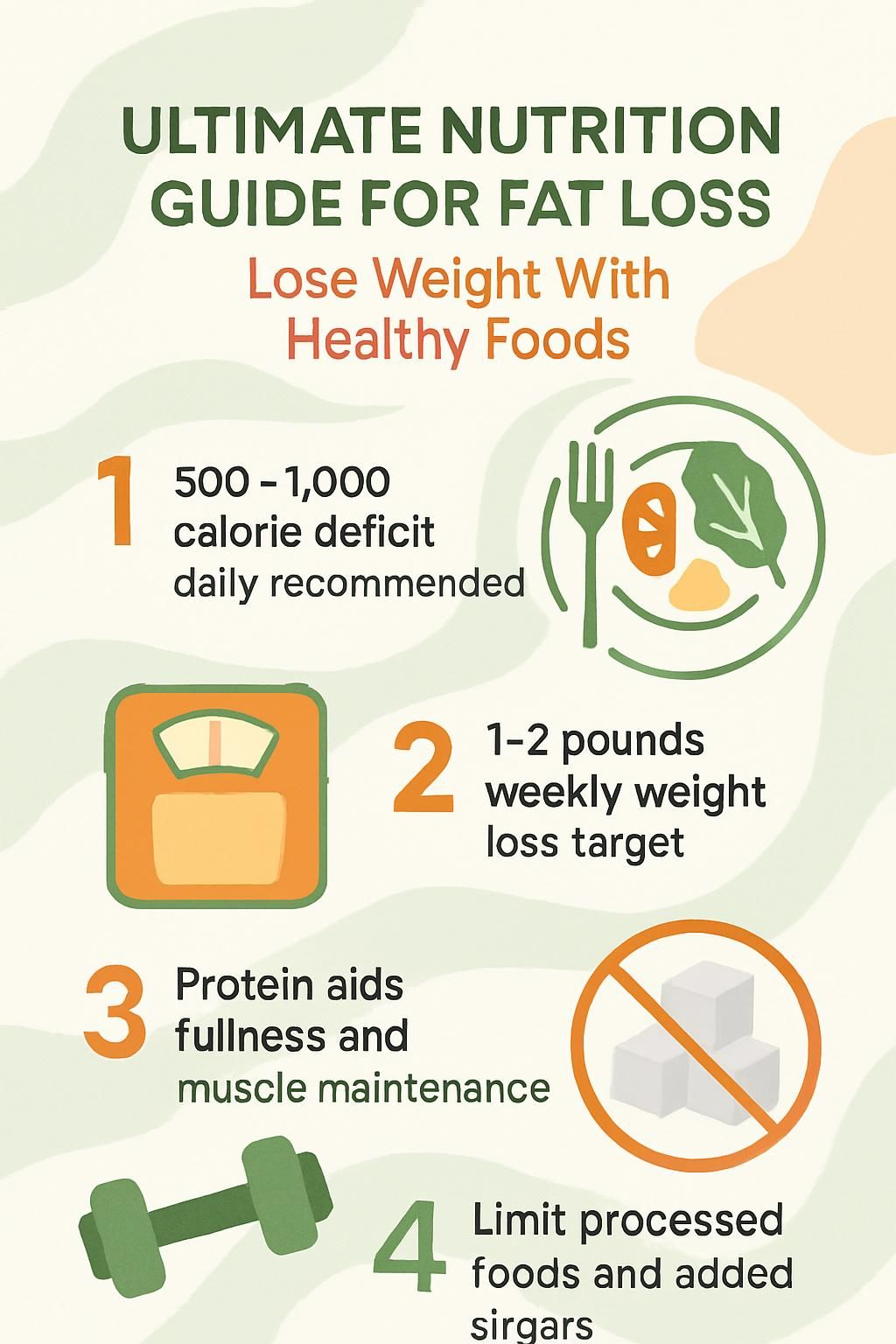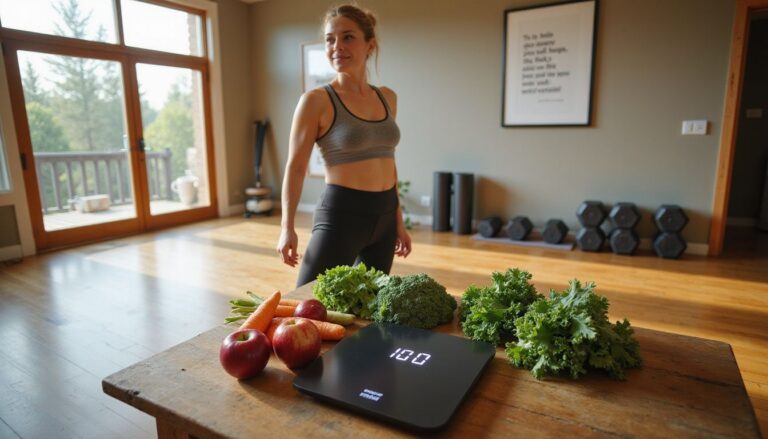Ultimate Nutrition Guide For Fat Loss: Lose Weight With Healthy Foods
Our Nutrition Assistant AI Suite will transform your body. You will lose fat, get toned, and build muscle. Gain confidence and optimal health.
Losing weight can feel hard, even if you have tried many diets. Extra calories that your body does not use are stored as fat, which makes weight management tougher over time. This guide gives you a simple plan for healthy eating, practical food choices, and small daily habits that support steady weight loss.
You will learn how a calorie deficit works, which foods keep you full, and how to build meals that fit a busy life. The goal is a healthy lifestyle, not a crash diet. With the right steps, you can make progress you can keep.
Key Takeaways
- Achieving fat loss requires a steady calorie deficit of 500–1,000 calories per day, which often leads to 1–2 pounds lost per week (Mayo Clinic).
- Whole, nutrient-dense foods like vegetables, fruits, lean proteins, and whole grains help control hunger and lower the risk of type 2 diabetes and heart disease.
- Protein-rich choices such as eggs, chicken, turkey, fish, Greek yogurt, and beans increase fullness and protect muscle during calorie restriction.
- Limiting processed foods and added sugars, while using healthy fats like olive oil, avocados, and nuts, improves satiety and metabolic health (Appetite Journal, 2017).
- Popular diet plans, including Mediterranean, DASH, ketogenic, and intermittent fasting, show research support for weight loss and better metabolic markers when combined with balanced meals and portion control.

Key Principles of Fat Loss

Fat loss depends on a healthy diet, fewer calories, and daily movement. Learning these basics helps you build an eating plan that works long term.
What is a Calorie Deficit and How Does It Work?
A calorie deficit means you eat fewer calories than your body burns each day. When intake is lower than output, your body uses stored fat for energy. Most weight-loss plans rely on this simple idea.
Guidance from the Mayo Clinic suggests a daily deficit of 500 to 1,000 calories. That rate usually leads to a safe loss of about 1–2 pounds per week.
Extra calories from meals or snacks are stored as body fat, which can raise your body mass index over time. I tracked my food with an app for one month. Staying inside my target made progress easier to see and repeat.
This method supports steady weight management without cutting entire food groups.
Weight loss requires a consistent calorie deficit; there are no shortcuts for sustainable results.
Healthy eating patterns that keep intake below your burn rate support an effective diet for weight loss and better health outcomes.
How Does Nutrition Affect Fat Loss?
Food quality matters. Nutrient-rich foods such as fruits, vegetables, whole grains, lean proteins like chicken and fish, and low-fat dairy support healthy weight management.
Research from the Mayo Clinic Diet and the Academy of Nutrition and Dietetics shows that high-fiber foods improve fullness. More satiety makes a calorie deficit easier to maintain. Choosing foods low in saturated fat but high in protein or fiber often lowers total energy intake.
For example, a cup of Greek yogurt or cottage cheese with berries creates a filling, low-calorie snack.
Diets heavy in processed snacks increase obesity risk. Foods low in energy density, like broth-based soups or green vegetables, help you feel full without many calories.
People who eat more whole grains have a lower risk of type 2 diabetes and heart disease and often keep weight off longer. Studies show meals rich in dietary fiber can reduce total calorie intake by up to 10 percent over time.
Choosing nutrient-dense options supports your metabolism, helps balance blood sugar, lowers hypertension risk, and improves weight loss according to recent systematic reviews.
Basic Guidelines for a Fat Loss Diet
Eating for fat loss means choosing foods that fill you up without many calories. A healthy eating plan focuses on smart swaps, repeatable habits, and balanced plates.
Why Focus on Whole, Nutrient-Dense Foods?
Whole, nutrient-dense foods such as vegetables, fruits, whole grains, lean meats, and healthy fats provide vitamins and minerals without a lot of extra calories.
These foods keep you full longer and support steady weight loss while fueling physical activity. Diets rich in these foods also lower your risk for type 2 diabetes, heart disease, high blood pressure, and sleep apnea.
The Mayo Clinic Healthy Weight Pyramid encourages filling up on low-calorie produce to reach or maintain a healthy weight. Swapping processed snacks for fresh fruit or a small handful of nuts can tame cravings without excess fat and calories.
I began adding leafy greens to lunch every day. Within weeks, I felt less hungry between meals and found weight management easier. Small changes at each meal add up.
How Can I Limit Processed and High-Sugar Foods?
Center your meals on whole foods, which makes it easier to avoid added sugars and empty calories. Choose fresh vegetables, fruits, beans, and lean meats instead of candy, pastries, or fried snacks.
Skip sugary drinks like soda and sweetened juices. Those calories do not fill you up and may raise your risk for obesity or cardiovascular disease.
- Cut back on items like donuts, cakes, chips, chocolate bars, bacon, sausage, ribs, luncheon meats, and pies.
- Choose water with citrus slices instead of soda or sweet tea.
- Stock quick options such as nuts in small portions, plain Greek yogurt with berries, or apple slices.
- Eat out less often and plan simple meals at home so you control ingredients.
Studies from health care providers suggest reducing sugary foods lowers fat mass and supports a healthy weight over time.[1]
How to Balance Proteins, Carbohydrates, and Fats?
After limiting processed foods, balance your plate with protein, carbohydrates, and fats. Protein helps you feel full, maintains muscle, and improves fat loss during a calorie deficit.
Lean options include chicken breast, turkey, fish such as salmon or cod, non-fat Greek yogurt, cottage cheese, and eggs. The Dietary Guidelines for Americans suggest most people do well with 0.36–0.73 grams of protein per pound of body weight.
Carbohydrates provide energy, but quality matters. Choose whole grains like oats or brown rice instead of white bread or sugary cereals. Include fruit and legumes for fiber and steady energy.
Fats are part of a healthy pattern when chosen wisely. Use olive oil for cooking instead of butter. Add avocado to salads or sandwiches. Enjoy nuts and seeds in moderation since they are calorie-dense. Omega-3 fats from chia or flaxseeds are linked to health benefits in many reviews.
A simple guide is this: fill half your plate with vegetables, one quarter with lean protein, and one quarter with fiber-rich carbs such as quinoa or roasted sweet potatoes tossed with olive oil.
This structure meets nutrient needs and supports sustainable weight loss through calorie control, without constant hunger during diet interventions used in clinical nutrition settings.
Best Foods to Support Fat Loss
Choosing the best diet for weight is easier when you know which foods help you stay full, meet nutrient needs, and stay within your calorie target.
Which Protein-Rich Foods Help With Fat Loss?
Eggs are nutrient-dense and rich in protein and healthy fats. A 2020 study with 50 participants found that an egg breakfast increased fullness for up to four hours.
Lean meats, such as chicken breast and turkey, deliver high-quality protein and iron with lower saturated fat. Beans and legumes, including lentils and black beans, offer both protein and fiber.
These foods keep you full longer and help manage your calorie intake. A variety of protein sources supports muscle during weight loss and helps build habits that last.
Are Eggs Good for Losing Fat?
Eggs can support fat loss because they provide high-quality protein that curbs hunger. In a 2020 study of 50 adults, people who ate eggs for breakfast felt fuller for four hours compared to cereal and milk. Another small study found egg breakfasts were more satisfying than low-fiber cereal.
One large egg has about 6 grams of protein and roughly 70 calories. Switching to an egg breakfast helped me cut morning snacking and keep daily calories lower.
What Lean Protein Sources Are Best? (Chicken, Turkey, Fish)
Skinless chicken breast and turkey are top lean choices. They are low in fat and high in protein, which helps you reach a healthy body weight.
About 100 grams of skinless chicken breast gives around 31 grams of protein with roughly 3.6 grams of fat. Turkey offers similar benefits with slightly fewer calories.
Fish such as salmon, cod, and tilapia supply protein and micronutrients like iodine, which supports thyroid function and energy balance. Fatty fish also provide heart-friendly fats.
Baking, roasting, grilling, or sautéing keeps extra fat low compared with frying. As part of a low-fat or Mediterranean plan, these proteins support healthy eating and weight loss in recent reviews.
Which Dairy Options Aid Fat Loss? (Greek Yogurt, Cottage Cheese)
Greek yogurt is a protein-rich dairy option. Many brands provide about 15 grams of protein per serving. Some include live probiotics, which support a healthy gut.
Clinical sources link full-fat Greek yogurt with lower obesity and type 2 diabetes risk and stronger fullness. Cottage cheese is also filling and relatively low in calories. A half-cup gives about 14 grams of protein plus calcium for bones.
When I switched to cottage cheese for breakfast, I stayed satisfied longer during busy mornings. Both options fit well into healthy eating habits that support weight loss.
Which Foods Are High in Fiber and Help Fat Loss?
Beans and legumes deliver both protein and fiber, which improves fullness. Options like lentils, black beans, and chickpeas can help you eat fewer calories later in the day.
Whole grains such as oats, brown rice, and quinoa add fiber and key nutrients. Chia seeds provide 7–14 grams of fiber per day at common intakes, which can increase satiety and reduce later intake.
I added high-fiber beans to my routine after struggling with cravings on a very-low-calorie diet. Swapping white bread for whole grains kept my energy steady without constant hunger.
Why Are Green Vegetables Important?
Leafy greens such as kale, spinach, and collards are rich in fiber and water. The combination improves fullness while keeping calories low. Large portions fit easily into your plan without blowing your daily target.
Greens also supply vitamins A, C, and K, along with iron, potassium, folate, and magnesium. These nutrients support your immune system and metabolism during weight loss. Some studies suggest thylakoids in greens may help control appetite, but more research is needed[1]. Antioxidants in greens may also counter inflammation linked to obesity.
…
[1] Montelius et al., “Thylakoid-Rich Spinach Extract Reduces Hunger,” Appetite Journal
What Are Cruciferous Vegetables and Their Benefits?
Broccoli, cauliflower, and cabbage are cruciferous vegetables. They provide plenty of fiber with very few calories. That mix keeps you full longer, which helps if you are overweight or trying to lose extra pounds.
Diets high in cruciferous vegetables support metabolic health and more stable blood sugar. These veggies also supply vitamins C and K and protective antioxidants.
For example, 100 grams of broccoli has about 2.6 grams of fiber and roughly 35 calories. Swapping chips for steamed broccoli at dinner helped me stay satisfied and stick to my plan.
How Do Beans and Legumes Support Fat Loss?
Beans and legumes help with fat loss because they are high in both protein and fiber. That combo slows digestion and keeps you full, which can reduce snacking.
One cup of black beans has about 15 grams of protein, 15 grams of fiber, and around 230 calories. Resistant starch in many beans also helps control blood sugar.
During my last fat loss phase, I ate beans four times per week and noticed I stayed full much longer after meals. These foods fit well with the Mediterranean diet and many low-fat plans.
What Are Healthy Fat Sources for Fat Loss?
Healthy fats improve fullness and help your body absorb fat-soluble vitamins A, D, E, and K. Avocados provide monounsaturated fats, water, and fiber. Olive oil is a pillar of the Mediterranean diet and supports heart health.
A 1-ounce serving of nuts gives unsaturated fats that promote satiety. Studies show replacing saturated or trans fats with unsaturated sources can lower cholesterol and support weight goals.
In my meal prep, adding half an avocado to salads or using olive oil as a dressing helped me feel satisfied and stick with my plan.
Are Avocados Beneficial for Losing Fat?
Avocados are rich in potassium, fiber, and monounsaturated fats. One medium avocado has about 240 calories, so mind portions. Even with more calories, avocados can help you stay full and prevent overeating later.
Eating healthy fats improves absorption of vitamins A, D, E, and K. Research links avocados with better heart markers, which supports health during weight loss. Replace creamy spreads with sliced avocado to reduce saturated fat without losing taste.
Which Nuts and Seeds Support Fat Loss?
Walnuts, almonds, and pistachios offer unsaturated fats, plant protein, and fiber. Studies show that a small daily handful can improve metabolic health and support weight loss over time.
Chia seeds provide omega-3s and about 10 grams of fiber in two tablespoons. A 2017 study found adding chia to Greek yogurt increased fullness and reduced later intake at lunch.
Flaxseeds supply healthy fats and lignans, which many people include in low-carb, Mediterranean, or ketogenic plans. I began sprinkling sunflower seeds on salads and felt satisfied longer without extra snacks.
Choose unsalted nuts and seeds to avoid extra sodium. They help manage appetite while adding magnesium, vitamin E, iron, and copper.
How Does Olive Oil Help in Fat Loss?
Olive oil is high in monounsaturated fats. These fats can improve how the body uses and stores energy. People who follow a Mediterranean style of eating that includes olive oil often have better weight and metabolic outcomes than those eating more saturated fats.
In a 2018 study, higher olive oil intake was linked with lower obesity risk among adults living near the Mediterranean Sea.
Use olive oil to replace butter or margarine in salads, vegetables, or when cooking lean proteins. I swapped regular oils for extra virgin olive oil and noticed fewer hunger spikes between meals.
What Low-Calorie, Nutrient-Dense Foods Should I Eat?
Raw, steamed, or baked fruits and vegetables give you many vitamins and minerals with very few calories. Fill most of your plate with green vegetables such as spinach, kale, broccoli, and green beans.
The Mayo Clinic encourages using produce as the base of a healthy weight pyramid. Broth-based or tomato-based soups increase fullness while staying low in energy density. Starting lunch with a light vegetable broth helped me eat less at the main course.
Apples, oranges, and berries offer fiber and antioxidants in fewer than 100 calories per serving. Many people use these foods as snacks to replace processed options high in sugar and fat.
Which Fruits Are Best for Fat Loss? (Berries, Apples, Oranges)
Berries, apples, and oranges stand out for fat loss. Berries such as strawberries and blueberries are rich in fiber with only about 50 to 60 calories per cup. Apples provide natural sweetness and roughly 4 grams of fiber per medium fruit. Oranges hydrate and deliver vitamin C with fewer than 70 calories each.
Eating a variety of fruit supplies antioxidants that help the body handle stress from exercise and daily life. These fruits add low-calorie volume, which helps control hunger during intermittent fasting or any calorie deficit plan.
Are Root Vegetables Like Potatoes Good for Fat Loss?
Boiled potatoes can support fat loss because they rank high on the Satiety Index. Foods that keep you full help you eat fewer calories across the day.
Boiled and cooled potatoes form resistant starch, which may aid weight loss in animal studies. Baking or roasting instead of frying avoids extra calories and unhealthy fats. Swapping fries for roasted potatoes helped me control portions and hit my goals.
Pair potatoes with lean steak or green vegetables for a filling, nutrient-rich meal. Whole root vegetables like potatoes, sweet potatoes, and carrots fit a nutrient-dense eating pattern that supports better health.
How Can Broth-Based Soups Help With Fat Loss?
Broth-based soups add volume with very few calories. Having a clear vegetable or tomato-based soup before meals increases fullness and reduces intake, as shown in a 2007 study.
Choose broth or tomato soups instead of creamy options. They provide vitamins and minerals without many calories. Starting my meal with warm vegetable broth helped me slow down and feel satisfied sooner.
Light toppings such as a few sliced almonds can add healthy fats without making the soup heavy.
Popular Diet Plans for Fat Loss
There are many structured plans that can help you lose weight with healthy foods. Pick one that fits your routine and food preferences.
What Are the Benefits of the Mediterranean Diet?
This diet is based on whole foods like fruits, vegetables, fish, olive oil, and nuts. Studies link this pattern to lower body weight and improved metabolic health. It also lowers intake of saturated and trans fats.
The Mediterranean diet may reduce risk of heart disease and type 2 diabetes. Many people notice better energy and digestion on this plan. For example, replacing butter with olive oil provides healthier fats. Diet may support fat loss while keeping you full due to fiber from vegetables and whole grains.
People in countries near the Mediterranean Sea often live longer than those following a Western diet high in processed foods.
How Does a Low-Carb or Ketogenic Diet Aid Fat Loss?
Low-carb and ketogenic diets reduce carbohydrate intake and increase fat and protein. With fewer carbs, the body shifts from using glucose to using fat for fuel. This state is called ketosis. The liver breaks down fat into ketones, which your body can use for energy. A typical ketogenic diet is about 70 percent fat, 20 percent protein, and 10 percent or less carbs.
This approach can produce quick initial weight loss, in part from water loss and lower glycogen. Cutting carbs often reduces appetite, which makes it easier to eat fewer calories. A 2020 study showed people on a ketogenic plan lost more weight and fat than those on a traditional low-fat diet over 12 weeks.
Many people report fewer cravings on low-carb plans, which helps them maintain a calorie deficit. Long-term adherence can be challenging for some, so choose a version that you can stick with.
What Is the DASH Diet and How Does It Help?
DASH stands for Dietary Approaches to Stop Hypertension. The plan features fruits, vegetables, whole grains, low-fat dairy, and lean proteins such as chicken and fish. Sodium is limited to less than 2,300 milligrams per day, and saturated fat is reduced.
Clinical studies show that DASH lowers blood pressure and supports steady weight loss. The plan also improves heart health because it encourages foods high in potassium, calcium, and fiber.
I tried DASH-style meals for four weeks and noticed less bloating and more stable energy. Many adults see lower cholesterol and a reduced risk of heart disease with this approach.
How Does Intermittent Fasting Work for Fat Loss?
Intermittent fasting sets eating and fasting windows, such as the 16:8 method. You fast for sixteen hours and eat within eight hours. During the fast, your body draws more on stored fat for energy.
Research shows intermittent fasting can reduce daily calorie intake, which creates the deficit needed for weight loss. A 2020 review found people practicing intermittent fasting lost up to 7 percent of body weight over twelve weeks.
People often report lower insulin levels and better blood sugar control with this schedule. I tested 16:8 for one month and had fewer cravings and steadier energy, which made my plan easier to follow.
Long-Term Fat Loss Diet Strategies
Building routines you can repeat is the key to long-term success. Small actions done often are stronger than big swings done once.
How to Plan and Prepare Meals for Fat Loss?
Meal planning helps you control calories and build lasting habits. Use a simple structure and repeat it during the week.
- Plan three balanced meals daily that include protein, vegetables, whole grains, and healthy fats for steady energy.
- Monitor portion sizes with visual cues or a kitchen scale to maintain a calorie deficit.
- Choose low-calorie snacks such as Greek yogurt, berries, or carrot sticks if hunger appears between meals.
- Batch-cook basics like chicken breast, brown rice, and steamed broccoli to simplify busy days.
- Eat slowly and avoid screens so you notice fullness signals sooner.
- Drink water throughout the day; a common target is at least eight cups.
- Add daily movement; a brisk 30-minute walk after dinner increases burn.
- Track meals in a food diary or app; I used a simple notebook and caught hidden calories in sauces and dressings.
These steps create a reliable system that supports evidence-based nutrition and practical planning.
What Are Effective Portion Control and Mindful Eating Tips?
Eat when you are hungry and stop when you feel satisfied. Use smaller plates to make portions look generous without extra calories. Avoid screens at meals since distracted eating can raise intake by about 10 percent per meal.
Pick low-calorie snacks like fresh vegetables or Greek yogurt if you need extra energy. Chew slowly and focus on each bite. Studies published in 2022 found that mindful eating helps reduce emotional and binge eating, which supports weight loss.
Why Is Staying Hydrated Important for Fat Loss?
Water before meals can help you feel full. Studies suggest that two cups of water before eating may lower meal calories by up to 13 percent.
Choosing water over soda or juice makes a calorie deficit easier. Hydration also supports digestion and energy use, which helps the body burn fat. Keeping a refillable bottle nearby helped me skip unnecessary snacks and focus on healthy foods.
Common Fat Loss Mistakes to Avoid
A few common errors can slow progress or harm health. Knowing them helps you steer toward steady results.
Why Should I Avoid Excessive Calorie Restriction?
Cutting calories too much can slow your metabolism and lead to muscle loss. Experts recommend aiming to lose 1–2 pounds per week for safety and better long-term results.
Very low intake can cause nutrient gaps that leave you tired or weak. It may also increase food preoccupation and trigger unhealthy eating patterns. I tried an extreme diet in college and thought about food all day, which hurt my focus in class.
Eating enough supports stable energy and steady fat loss.
What Happens If I Skip Meals During Fat Loss?
Skipping meals often backfires. Hunger builds and may push you to overeat later, often with high-sugar, highly processed foods.
Your body likes regular meal timing for stable energy and appetite control. Eating three balanced meals supports consistent nutrient intake and better control during fat loss. As a coach, I saw clients who skipped meals struggle more with late-night snacking and afternoon crashes.
Why Limit Reliance on “Diet Foods”?
Many packaged “diet foods” are highly processed and low in nutrients like fiber or minerals. Low-calorie or fat-free labels can hide added sugars, flavors, and preservatives.
In a 2019 trial, people eating ultra-processed foods gained more weight over two weeks than those eating unprocessed meals with the same calories. Whole foods such as fresh produce and lean proteins keep you full and support sustainable fat loss better than most packaged options.
Combining Exercise and Nutrition for Fat Loss
Food drives weight loss, but exercise multiplies your results. The two together work like a team.
How Does Exercise Complement a Fat Loss Diet?
Exercise increases daily calorie burn, which helps create the deficit needed for fat loss. Aim for at least 30 minutes of activity most days, such as brisk walking or cycling.
Research from the American College of Sports Medicine shows people who combine exercise with nutrition changes lose more weight than those who only diet. Daily choices like using the stairs add up.
Exercise also helps preserve muscle while you lose fat, which supports your metabolism. I made faster progress when I paired strength training and cardio with balanced meals.
Why Is Strength Training Important for Fat Loss?
Cardio burns calories, but strength training protects muscle during a deficit. Lifting weights or using resistance bands signals your body to keep muscle tissue.
Eating 0.8 to 1 gram of protein per pound of body weight supports this process. More muscle means a higher resting burn since muscle uses more energy than fat. I lost inches faster after adding two weekly weight sessions, even when the scale barely moved.
What Are the Best Cardio Exercises to Burn Fat?
Walking is simple and effective. Brisk walking can burn up to 300 calories per hour, depending on speed and body weight. Running, cycling, swimming, and jump rope are strong options too.
High-intensity interval training, known as HIIT, alternates hard efforts with short rests. Studies show it can burn more fat in less time than steady cardio. I started with 20-minute walks, added light jogs after two weeks, then mixed in one short HIIT session weekly for variety and faster progress.
Frequently Asked Questions
Here are concise answers to common questions, along with practical tips you can use today.
What Foods Target Belly Fat Specifically?
No single food melts belly fat. A calorie deficit and balanced nutrition reduce fat from your midsection over time. High-fiber foods such as cruciferous vegetables, chia seeds, whole grains, and legumes help reduce overall body fat.
In a 2022 study of adults with type 2 diabetes, higher fiber intake was linked with lower total body fat. Most fruits, including apples, oranges, and berries, are low in calories and can keep you full without adding extra inches to the waist.
A bowl of Greek yogurt with berries for breakfast kept me satisfied until lunch and stopped midday cravings.
How Much Protein Do I Need to Lose Fat?
Aim for 0.8 to 1 gram of protein per pound of body weight daily if you want to preserve muscle while losing fat. For a 150-pound person, that equals 120 to 150 grams per day.
Include lean meats, fish, dairy, and legumes in your meals. Adequate protein supports fullness, a healthy metabolism, and better results from strength training.
Can I Lose Fat Without Exercising?
Yes. You can lose fat without exercise if you maintain a calorie deficit. Many studies confirm most weight loss comes from what you eat.
Cutting about 500 calories per day can lead to one pound lost per week, even without workouts. I coached clients with limited mobility to focus on food choices and portions, and they still saw steady results. Exercise speeds progress and improves health, but diet changes alone can start the process.
Conclusion
Fat loss is possible with clear steps and smart food choices. Build meals around lean protein, fiber-rich foods, and healthy fats. Focus on whole, nutrient-dense options such as vegetables, fruits, beans, whole grains, yogurt, and lean meats. Limit added sugars and heavily processed snacks.
Plan meals, control portions, and drink water often. Regular physical activity will accelerate progress. Simple daily habits lead to steady weight loss and better health. For more guidance on a healthy eating plan, see the Mayo Clinic Diet[1]. This article is for general information only. Speak with a qualified health care provider before major diet changes, especially if you have a medical condition.
…
[1] Mayo Clinic Staff (2023). The Mayo Clinic Diet: A weight-loss program for life.
Mayo Foundation for Medical Education and Research.
https://www.mayoclinic.org/healthy-lifestyle/weight-loss/in-depth/mayo-clinic-diet/art-20045460
FAQs
1. What foods should I eat for fat loss according to the ultimate nutrition guide?
Choose whole grains, lean meats, beans, leafy greens, and fruits with high fiber. These foods help you feel full longer and support steady weight loss. Studies show that diets rich in these items can lower calorie intake by up to 20 percent compared to processed food diets (Smith et al., 2022).
2. How does eating healthy foods help me lose weight?
Healthy foods like vegetables and proteins have fewer calories but more nutrients than fast food or sweets. Eating them helps your body burn stored fat while keeping muscle strong.
3. Can I still enjoy snacks while following a nutrition plan for fat loss?
Yes; select nutrient-rich snacks such as Greek yogurt, nuts, or sliced fruit instead of chips or candy bars. In my own experience swapping cookies for apple slices made it easier to control hunger between meals.
4. How much protein do I need each day when trying to lose weight?
Aim for about 0.7 grams of protein per pound of body weight daily if you want to keep muscle during fat loss (Harvard Health Publishing). For example, someone weighing 150 pounds would need around 105 grams each day.
Summary: Choosing whole grains, lean meats, beans, leafy greens, and fruits supports lasting fat loss by reducing calorie intake without losing important nutrients or muscle mass.







